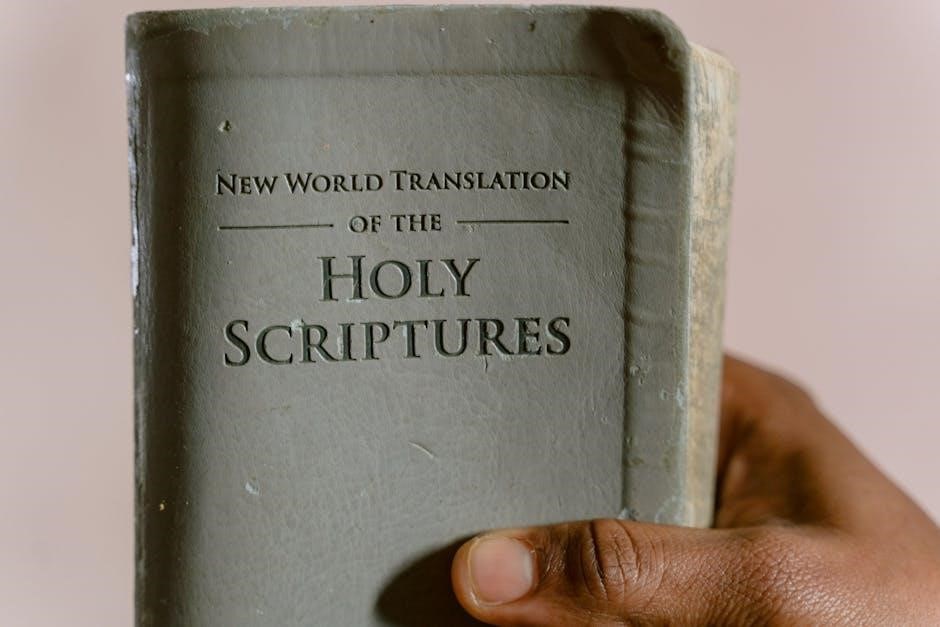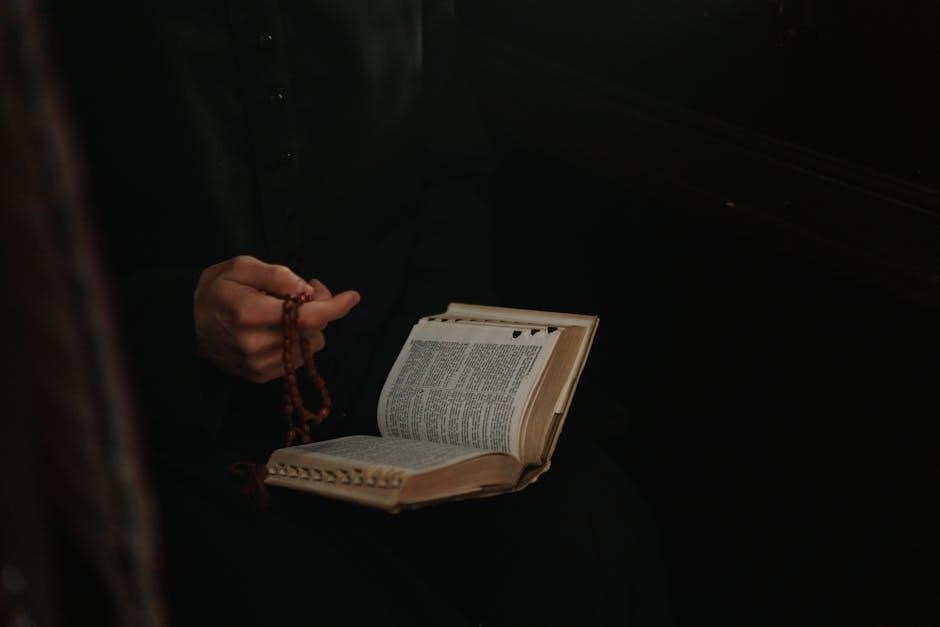The Catholic Bible Timeline Chart is a valuable resource for understanding the chronological structure of Scripture. It organizes key events and figures from both the Old and New Testaments, providing a clear visual guide. Available as a PDF, this chart helps deepen biblical knowledge and connects the dots between historical events and spiritual themes, making it an essential tool for personal or group study.
Overview of the Catholic Bible Timeline Chart
The Catholic Bible Timeline Chart is a comprehensive visual tool designed to organize the key events, figures, and periods of the Catholic Bible in chronological order. Available as a downloadable PDF, it provides a clear and structured overview of the biblical narrative, spanning from creation to the early Church. This chart is particularly useful for Bible study programs, such as Jeff Cavins’ The Bible Timeline, which helps participants understand the story of salvation. It includes major events from both the Old and New Testaments, highlighting the connections between historical and spiritual elements. The chart serves as an essential resource for personal or group study, offering a visual framework to deepen one’s understanding of Scripture and its relevance to Catholic teachings.
Importance of Understanding the Timeline
Understanding the Catholic Bible Timeline Chart is crucial for grasping the story of salvation and the unity of Scripture. It reveals how historical events and spiritual themes interconnect, providing context for biblical narratives. By studying the timeline, Catholics can appreciate the progression of God’s plan from creation to the establishment of the Church. This knowledge enhances prayer, personal reflection, and communal worship. It also aids in understanding the relevance of biblical events to modern life, fostering a deeper faith connection. The timeline serves as a foundational tool for Bible study, enabling believers to engage more meaningfully with the Word of God and its enduring message of salvation.
Structure and Content
The Catholic Bible Timeline Chart is structured to present the entire story of salvation in chronological order. It spans from creation to the Second Coming, dividing the Bible into clear periods. The chart includes events from both the Old and New Testaments, highlighting key figures such as Adam, Abraham, Moses, and Jesus. It also features major prophets like Isaiah, Jeremiah, and Ezekiel, as well as the apostles Peter and Paul. The timeline is divided into 12 color-coded periods, each with specific themes and events. These periods include the Early World, the Patriarchs, Moses and the Exodus, and the Life of Jesus. Additional details like maps and summaries of key events enhance understanding. The chart’s content is designed to show how the entire Bible fits together, making it a comprehensive and accessible study tool for Catholics.

Historical Background of the Catholic Bible
The Catholic Bible encompasses a rich history, spanning creation to the early Church. Its timeline highlights key events like the Exodus, Kingdom of Israel, and life of Jesus, forming the narrative of salvation history.
Old Testament Periods and Key Events
The Old Testament spans from creation to the period of the prophets. Key events include creation (4000 BC), Abraham’s birth (2165 BC), and Joseph’s family moving to Egypt (1876 BC). Major periods like the Exodus (1406 BC) and the Conquest of Jericho (1389 BC) are highlighted. The timeline also covers the Judges’ period, starting with Othniel (1367 BC) and Ehud (1309 BC). Prophets such as Elijah, Elisha, and Isaiah played crucial roles, addressing both Israel and Judah. These events form the foundation of salvation history, leading up to the New Testament and the life of Jesus Christ.
New Testament Periods and Key Events
The New Testament periods and key events are meticulously outlined in the Catholic Bible Timeline Chart, starting with the life of Jesus Christ. His ministry, death, and resurrection form the cornerstone of the narrative. The chart also details the Acts of the Apostles, focusing on Peter, Paul, and their missionary journeys. Key events include the Pentecost, the conversion of St. Paul, and the spread of Christianity across the Mediterranean. The timeline aligns these events with Catholic teachings, emphasizing their significance. It also highlights the writings of the apostles, such as the Epistles of Peter, John, and Jude, and concludes with the Book of Revelation. This chronological arrangement aids in understanding the New Testament’s structure and its enduring relevance for modern Catholic study and reflection.

Major Prophets and Their Contributions
The Catholic Bible Timeline Chart highlights the roles of major prophets, such as Elijah, Elisha, Hosea, and Isaiah, who played crucial roles in guiding Israel and Judah. These prophets delivered divine messages, calling people to repentance and faithfulness. Elijah and Elisha performed miracles, demonstrating God’s power, while Hosea and Amos emphasized justice and mercy. Isaiah and Jeremiah foresaw the coming Messiah and the restoration of Israel. Their ministries, recorded in both the Old Testament and the timeline chart, provide a rich tapestry of God’s interaction with humanity. The prophets’ contributions are essential for understanding the theological and historical framework of the Bible, making them a cornerstone of the Catholic faith and study.

Key Features of the Catholic Bible Timeline Chart
The Catholic Bible Timeline Chart offers a chronological arrangement of biblical events, covering both Old and New Testaments. It highlights key figures, their roles, and significant events, providing a clear visual guide to understanding Scripture in a structured and organized manner.
Chronological Arrangement of Biblical Events
The Catholic Bible Timeline Chart organizes events from Creation to the Apostolic Era in chronological order. It begins with key events like the creation of Adam and Eve (circa 4000 BC) and the birth of Abraham (around 2165 BC). The timeline progresses through significant moments such as Joseph’s move to Egypt (1876 BC) and Moses’ death (1406 BC). It also covers the period of the Judges, starting with Othniel (1367 BC) and Ehud (1309 BC), and the conquest of Jericho (1389 BC). This structure helps users visualize the flow of biblical history, connecting Old Testament events to the New Testament narrative, and emphasizing God’s plan of salvation. The chart’s clear arrangement makes it easier to study and understand the Bible’s historical context.
Inclusion of Both Old and New Testaments
The Catholic Bible Timeline Chart seamlessly integrates events from both the Old and New Testaments, providing a holistic view of salvation history. It begins with Creation (circa 4000 BC) and traces key moments in the Old Testament, such as the Exodus from Egypt and the conquest of Jericho. The chart transitions smoothly into the New Testament, highlighting the life of Jesus Christ, His ministry, and the establishment of the Church through the Apostles. This inclusive approach emphasizes the continuity of God’s plan, connecting the covenants of the Old Testament to the fulfillment in the New Testament. By covering both testaments, the chart offers a complete understanding of the Bible’s narrative, making it an invaluable tool for studying the Catholic faith and its rich historical roots. This comprehensive view helps users appreciate the unity of Scripture.
Highlighting Key Figures and Their Roles
The Catholic Bible Timeline Chart emphasizes the roles of key figures in biblical history, such as prophets, apostles, and significant leaders. Major prophets like Isaiah, Jeremiah, and Elijah are highlighted, showcasing their contributions during critical periods. In the New Testament, figures like Jesus, Mary, and the Apostles are central, with their ministries and teachings clearly outlined. The chart also includes lesser-known but important figures, such as the judges and kings of Israel, providing context for their impact on salvation history. By visually representing these individuals and their roles, the timeline helps users understand their significance in the broader narrative of Scripture. This focus on key figures makes the chart an invaluable resource for studying the Bible’s most influential personalities and their divine missions. It bridges the gap between historical events and spiritual teachings, enhancing the study experience.

How to Use the Catholic Bible Timeline Chart
The Catholic Bible Timeline Chart can be effectively used by aligning it with Catholic teachings and integrating it into Bible study for a deeper understanding of Scripture.
Aligning the Timeline with Catholic Teachings
The Catholic Bible Timeline Chart is designed to align seamlessly with Catholic teachings, offering a structured framework for understanding the unity of Scripture. By organizing events chronologically, it reflects the Church’s emphasis on salvation history, highlighting how key moments in the Bible prepare for and fulfill God’s plan of redemption. This alignment helps Catholics see the continuity between the Old and New Testaments, as well as the fulfillment of prophecies in Jesus Christ.
Using the timeline alongside Catholic doctrine, believers can deepen their appreciation of how historical events and figures, such as Moses, the prophets, and the apostles, contribute to the Church’s teachings. This resource is particularly useful for RCIA programs, Bible studies, and personal reflection, providing a clear and faith-enriching perspective on Scripture;
Integrating the Timeline into Bible Study
Integrating the Catholic Bible Timeline Chart into Bible study enhances understanding by providing a visual framework of key events and their chronological order; This resource helps participants connect the dots between Old and New Testament narratives, seeing how they interweave to reveal God’s plan of salvation. By using the timeline, individuals and groups can follow along with Bible readings, ensuring a deeper grasp of the historical and theological context of each passage.

The chart is particularly effective for guided studies, as it allows leaders to highlight connections between events and Catholic doctrine. It also serves as a reference for personal reflection, enabling believers to explore Scripture systematically. This integration fosters a more comprehensive and engaging approach to Bible study, making the timeline an invaluable tool for spiritual growth and education.
Practical Applications for Personal and Group Study
The Catholic Bible Timeline Chart offers versatile applications for both personal and group study. For individuals, it serves as a visual guide to track progress through Scripture, helping to illuminate the sequence of events and their significance. This clarity enhances meditation and reflection, making biblical narratives more relatable. In group settings, the chart acts as a shared reference, fostering collaborative learning and discussion. Leaders can use it to structure lessons, while participants can follow along, deepening their understanding of Catholic teachings. Its portability and accessibility make it ideal for various educational contexts, ensuring that learners at all levels can engage with the Bible’s rich history effectively.

Downloading and Accessing the PDF
The Catholic Bible Timeline Chart is available as a free PDF download. Visit the official website, locate the download button, and save the file for easy access and printing.
Steps to Download the Jeff Cavins Bible Timeline Chart
To download the Jeff Cavins Bible Timeline Chart, visit the official website and navigate to the chart’s page. Scroll down to find the download button labeled “Download Bible Timeline Chart.” Click on it and select the PDF format from the available options. Once the download begins, save the file to your device. The chart is free and easily accessible, ensuring you can start exploring the biblical timeline without hassle. This resource is perfect for personal study or group discussions, providing a clear and structured overview of key events and figures in Scripture.
Free Resources and Tools Available Online
Besides the Jeff Cavins Bible Timeline Chart, numerous free resources are available online to enhance your study. Websites offer downloadable PDF guides, Bible reading plans, and supplementary materials that complement the timeline. These resources include detailed outlines of biblical periods, maps, and study aids. Many Catholic ministries provide free access to these tools, ensuring that everyone can deepen their understanding of Scripture. The availability of these resources makes it easier for individuals and groups to engage with the Bible in a structured and meaningful way, fostering a deeper connection to the faith.
Printing and Sharing the Timeline Chart
The Catholic Bible Timeline Chart is easily printable in PDF format, allowing for clear and high-quality reproduction. Once downloaded, users can print the chart on standard or glossy paper for enhanced readability. Sharing the timeline is straightforward, as the digital file can be emailed or uploaded to online platforms. Many find it useful to display the chart in classrooms, churches, or homes for group study. Additionally, the chart can be shared with others interested in deepening their biblical knowledge. Its portability and accessibility make it a versatile tool for both personal and communal use, fostering engagement and understanding of the Catholic Bible’s historical narrative.
The Catholic Bible Timeline Chart PDF is a valuable resource for enhancing scriptural understanding. It provides a clear, organized overview of biblical events, making it essential for deeper faith engagement. Whether for personal reflection or group study, this tool fosters a greater appreciation of God’s plan. Highly recommended for those seeking to connect with the Bible’s timeless message.
The Value of the Timeline in Bible Study
The Catholic Bible Timeline Chart offers immense value for Bible study by providing a visual and chronological framework of sacred events. It helps readers understand the sequence of biblical history, connecting the Old and New Testaments seamlessly. This tool is particularly useful for resolving confusion about the order of events and highlighting key transitions, such as the shift from the Old Covenant to the New. The timeline also underscores the unity of Scripture, revealing how every event points to God’s ultimate plan of salvation. For both individual and group study, the timeline enhances comprehension, fosters deeper engagement, and serves as a quick reference for exploring the Bible’s rich narrative. Its clarity and structure make it an indispensable resource for anyone seeking to grow in biblical knowledge and faith.

Encouragement to Explore Further
Exploring the Catholic Bible Timeline Chart is an invitation to embark on a transformative journey through Scripture. By engaging with this resource, individuals can gain a deeper appreciation for the interconnectedness of biblical events and the unfolding of God’s plan. The timeline not only enhances understanding but also sparks curiosity, encouraging readers to delve into specific stories and themes. It serves as a gateway to a richer, more meaningful relationship with the Word of God. Encouraging further exploration, the chart motivates learners to seek additional resources, such as commentaries or study guides, to enrich their spiritual growth. Embrace this tool as a starting point and let it inspire a lifelong commitment to studying and living the teachings of the Bible.
Final Recommendations for Users
To maximize the benefits of the Catholic Bible Timeline Chart, users are encouraged to print it on high-quality paper for clarity and durability. Consider laminating it for long-term use or displaying it in a study area for easy reference. Consider using the chart alongside Jeff Cavins’ Bible Timeline study program for a deeper understanding of Scripture. Share the chart with others to foster group discussions and collaborative learning. For those interested in further study, explore additional resources like the Bible Timeline reading plan or complementary study guides. By integrating this tool into your spiritual routine, you can gain a richer understanding of the Bible’s narrative and its relevance to your faith journey. Embrace this resource as a cornerstone for meaningful and transformative biblical study.
